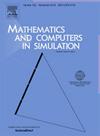Modelling of the additional motion resistance term in CFD simulations using porosity distributed resistance (PDR)
IF 4.4
2区 数学
Q1 COMPUTER SCIENCE, INTERDISCIPLINARY APPLICATIONS
引用次数: 0
Abstract
The numerical simulation of turbulent flows through groups of obstacles is essential in various industrial applications, particularly in the numerical modelling of accidental explosions. In such contexts, particular attention must be given to small-scale objects that impose flow resistance and contribute to turbulence generation. The Porosity Distributed Resistance (PDR) approach has been introduced as a practical method to address the complexity of simulating flow behaviour near small-scale objects. This study presents a novel model for the additional motion resistance term () within Computational Fluid Dynamics (CFD) simulations, specifically designed to enhance the PDR approach. Using CFD simulations conducted in CFX, we derived and validated the model by comparing simulation results with empirical correlations, demonstrating its dependence on cell volumetric porosity. This model was subsequently implemented and tested in STOKES, a CFD software tailored for explosion simulations that incorporates the PDR methodology. Our study also investigated the effects of computational mesh resolution on porosity distribution within the domain. Two key conclusions emerged: first, the proposed model significantly improves simulation accuracy when coarse computational meshes are employed—typical for large-scale industrial simulations, including gas dispersion and explosion scenarios; second, at finer mesh resolutions, the PDR concept renders the model impact negligible. Consequently, an influence radius is recommended for activating the term, ensuring optimal application within the computational domain.
基于孔隙分布阻力(PDR)的CFD模拟中附加运动阻力项建模
紊流通过障碍群的数值模拟在各种工业应用中是必不可少的,特别是在意外爆炸的数值模拟中。在这种情况下,必须特别注意施加流动阻力并导致湍流产生的小尺度物体。孔隙度分布阻力(PDR)方法作为一种实用的方法被引入,以解决模拟小尺度物体附近流动行为的复杂性。本研究提出了一个计算流体动力学(CFD)模拟中附加运动阻力项(Ri)的新模型,专门用于增强PDR方法。通过在CFX中进行CFD模拟,我们通过将模拟结果与经验相关性进行比较,推导并验证了Ri模型,证明了其与细胞体积孔隙度的相关性。该模型随后在STOKES中进行了实施和测试,STOKES是一款为爆炸模拟量身定制的CFD软件,结合了PDR方法。我们的研究还探讨了计算网格分辨率对区域内孔隙度分布的影响。得出了两个关键结论:首先,该模型在采用粗计算网格时显著提高了模拟精度,这是大规模工业模拟的典型特征,包括气体扩散和爆炸场景;其次,在更精细的网格分辨率下,PDR概念使Ri模型的影响可以忽略不计。因此,建议使用影响半径来激活Ri项,以确保在计算域内的最佳应用。
本文章由计算机程序翻译,如有差异,请以英文原文为准。
求助全文
约1分钟内获得全文
求助全文
来源期刊

Mathematics and Computers in Simulation
数学-计算机:跨学科应用
CiteScore
8.90
自引率
4.30%
发文量
335
审稿时长
54 days
期刊介绍:
The aim of the journal is to provide an international forum for the dissemination of up-to-date information in the fields of the mathematics and computers, in particular (but not exclusively) as they apply to the dynamics of systems, their simulation and scientific computation in general. Published material ranges from short, concise research papers to more general tutorial articles.
Mathematics and Computers in Simulation, published monthly, is the official organ of IMACS, the International Association for Mathematics and Computers in Simulation (Formerly AICA). This Association, founded in 1955 and legally incorporated in 1956 is a member of FIACC (the Five International Associations Coordinating Committee), together with IFIP, IFAV, IFORS and IMEKO.
Topics covered by the journal include mathematical tools in:
•The foundations of systems modelling
•Numerical analysis and the development of algorithms for simulation
They also include considerations about computer hardware for simulation and about special software and compilers.
The journal also publishes articles concerned with specific applications of modelling and simulation in science and engineering, with relevant applied mathematics, the general philosophy of systems simulation, and their impact on disciplinary and interdisciplinary research.
The journal includes a Book Review section -- and a "News on IMACS" section that contains a Calendar of future Conferences/Events and other information about the Association.
 求助内容:
求助内容: 应助结果提醒方式:
应助结果提醒方式:


